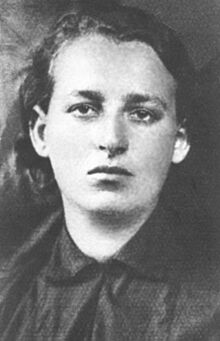Frumka Płotnicka facts for kids
Quick facts for kids
Frumka Płotnicka
|
|
|---|---|

Płotnicka was a leading member of the Z.O.B. in the Warsaw Ghetto and a leader in the uprising in the Będzin Ghetto during the Holocaust in Poland.
|
|
| Born | 1914 Plotnitsa, Russian Empire
|
| Died | 3 August 1943 (age 29) Będzin Ghetto, Poland
|
| Cause of death | Killed in action † |
| Nationality | Polish |
| Other names | Fruma (Frumke) Plotnitzki (anglicized) |
| Organization | |
| Known for | Będzin Ghetto Uprising leadership |
| Awards | Order of the Cross of Grunwald, Poland |
Frumka Płotnicka (born 1914 – died August 3, 1943) was a brave Polish resistance fighter during World War II. She was an important member of the Jewish Fighting Organization (ŻOB). This group was part of the Labour Zionist movement called Dror.
Frumka helped organize self-defense efforts in the Warsaw Ghetto. She also took part in planning for the Warsaw Ghetto Uprising. After the Warsaw Ghetto was destroyed, Płotnicka moved to the Dąbrowa Basin region in southern Poland. There, she helped set up a local ŻOB group in Będzin. She saw the terrible destruction of the Sosnowiec Ghetto and Będzin Ghetto by the German forces.
In August 1943, during the final deportations, the Jewish Fighting Organization in Będzin fought back. This uprising lasted for several days. Frumka Płotnicka died on August 3, 1943, while fighting the Germans in a bunker in Będzin. After her death, she was given the Order of the Cross of Grunwald award by the Polish government in April 1945.
Early Life and Resistance Work
Frumka Płotnicka was born in 1914 in Plotnitsa, a village near Pińsk. This area became part of Poland in 1919. In 1938, she moved to Warsaw to work at the main office of the Dror Zionist Youth Movement. This movement was started in Poland in 1915.
After Nazi Germany invaded Poland in 1939, Frumka began working secretly. She was a leader in the HeHalutz youth movement. She used fake names and disguises to travel between the Jewish ghettos in German-occupied Poland. She saw the Holocaust trains taking Jewish people from train stations to secret death camps. This was part of the Nazi plan to kill all Jewish people, known as the "Final Solution".
As a secret courier, also called a 'kashariyot', she delivered small weapons. These weapons were bought by the Warsaw Ghetto underground. She also carried plans for making Molotov cocktails and hand grenades. Jewish communities she visited called her "Die Mameh," which means "Mom" in Yiddish. She brought back news of many ghettos being destroyed. Because of this, she sadly started calling herself a "gravedigger."
Jews would flock around her from all sides. One would ask her if he should return home [in the German zone of occupation], or continue his way eastward to the Soviet-dominated provinces. Another would come in search of a hot meal or a loaf of bread for his wife and children. They called her 'Die Mameh' and indeed she was a devoted mother to them all. — Zivia Lubetkin
In September 1942, after a large roundup of Jews in Warsaw, Płotnicka was sent to Będzin. This was in occupied southern Poland. She went there to help the self-defense group. The Jewish Fighting Organization (ŻOB) had just started in the Warsaw Ghetto two months earlier. This was when the German SS began rounding up Jews to send 254,000 prisoners to the new Treblinka extermination camp. Frumka Płotnicka was the first Jewish courier in the Warsaw Ghetto to secretly bring weapons. She hid them inside sacks of potatoes from the non-Jewish part of the city.
Płotnicka also received a Paraguayan passport from a group called the Ładoś Group. This group helped Jewish people get passports to escape.
Będzin Ghetto Uprising
In the Będzin Ghetto, a Jewish underground group was formed in 1941. The ghetto was not surrounded by a wall, but it was heavily guarded by German and Jewish Ghetto Police. In March 1941, there were over 25,000 Jewish people in Będzin. This number grew to 27,000 after Jewish people from Oświęcim (where Auschwitz II Birkenau was built) were forced to move there.
In May 1942, deportations to Auschwitz began. The first transport took 3,200 Będzin Jews on Holocaust trains. They were loaded at the Umschlagplatz (a loading area). Following advice from Mordechai Anielewicz, Frumka Płotnicka and others organized a local chapter of ŻOB.
On August 3, 1943, during the final deportations, the resistance fighters started an uprising. It lasted for several days. Frumka Płotnicka was killed in a bunker on Podsiadły Street on that same day.
A stone memorial is placed at the corner of Niska and Dubois Streets in Warsaw. It remembers Frumka Płotnicka's life and bravery. This stone is part of a special Memory Trail of the Struggle and Martyrdom of the Jews in Warsaw. In 1957, Yad Vashem officially recognized Płotnicka as a victim of the Holocaust.
Awards
- Order of the Cross of Grunwald from the Polish Committee of National Liberation on April 19, 1945.
See also
- Bela Yaari Hazan

